
| Code | Material | Wavelength | Retardation | Aperture | Mount | Unit Price | Delivery | Cart |
|---|---|---|---|---|---|---|---|---|
| 20709-001 | UV Fused Silica | 210-400nm | λ/2 | 10mm | Mounted | Inquire | Inquire | |
| 20709-002 | UV Fused Silica | 210-400nm | λ/4 | 10mm | Mounted | Inquire | Inquire | |
| 20709-003 | BK7 | 350-2300nm | λ/2 | 10mm | Mounted | Inquire | Inquire | |
| 20709-004 | BK7 | 350-2300nm | λ/4 | 10mm | Mounted | Inquire | Inquire | |
| 20709-005 | ZnSe | 2000-15000nm | λ/2 | 10mm | Mounted | Inquire | Inquire | |
| 20709-006 | ZnSe | 2000-15000nm | λ/4 | 10mm | Mounted | Inquire | Inquire |
A Fresnel Rhomb Retarder is a special kind of optical retarder that produces a phase delay of λ/2 or λ/4 by utilizing internal reflection. Unlike conventional waveplates which function through the birefringence of materials to produce the required phase difference between the two orthogonal polarizations, the Fresnel Rhombs are made of non-birefringent materials and induce the desired phase delay after going through two total reflections. The retardation produced by a Fresnel rhomb depends almost solely on the refractive index and the geometries of the prism, and since the refractive index varies just slightly against a certain wavelength range, the independence of retardation over the wavelength changes is much greater, thus achieving extraordinarily flat retardation throughout a broad wavelength range, which could have been impossible in the case of broadband waveplates made of birefringent materials. This kind of broadband retarder is suitable for applications in diode and fiber applications, broadband, multi-line, or tunable laser sources.
The Fresnel Rhomb Retarder is usually shaped into a right parallelepiped, that is, a right parallelogram-based prism. The angles of the parallelograms are deliberately designed so that each reflection inside the rhomb, with the incident angles carefully chosen, adds a phase difference of precisely 1/8 wavelength between the two orthogonal polarization components, and ultimately resulting in a total phase delay of a quarter of a wavelength in the exiting light. Two quarter-retarders could be cemented together to achieve the effect of using a half-waveplate. The variation in retardance is within 2% across the wavelength range. The Fresnel Rhombs are good substitutes for broadband waveplates and UV waveplates, with extended wavelength bandwidth (broader than the Achromatic Waveplates) from the Ultraviolet to the IR wavelength spectral.
Hangzhou Shalom EO offers Fresnel Rhomb Retarder with either λ/2 or λ/4 retardance, for Ultraviolet, Visible, and LWIR applications. The Fresnel Rhomb Retarders made of BK7 operating at the wavelength range of 350-2300nm, UV Fused Silica ( wavelength range 210-400nm), and ZnSe (wavelength range 2000-15000nm) are procurable. Off-the-shelf products for online shopping are listed in the catalog, while custom products can be provided upon request.
Specifications:
| Material | UV Fused Silica/BK7/ZnSe | Aperture Diameter | 10.0mm |
| Wavelength Range | 210-400nm (UV Fused Silica), 350-2300nm (BK7), 2000-15000nm (ZnSe) | Retardation | λ/2 or λ/4 |
| Retardation Tolerance | +/-2° | Flatness | λ/10@632.8nm (UV Fused Silica), λ/10@632.8nm (BK7), λ/4@632.8nm (ZnSe) |
| Surface Quality | 20/10 S/D (UV Fused Silica), 20/10 S/D (BK7), 40/10 S/D (ZnSe) | Broad band AR Coating | R<1%@600-900nm |
| Mount | Mounted |
Retardation Curves:
The following graphs illustrate the retardation of Fresnel Rhomb Retarders over the wavelength ranges.
1. 210-400nm Fresnel Rhomb Retarders of UV Fused Silica (λ/2 and λ/4 retardance)
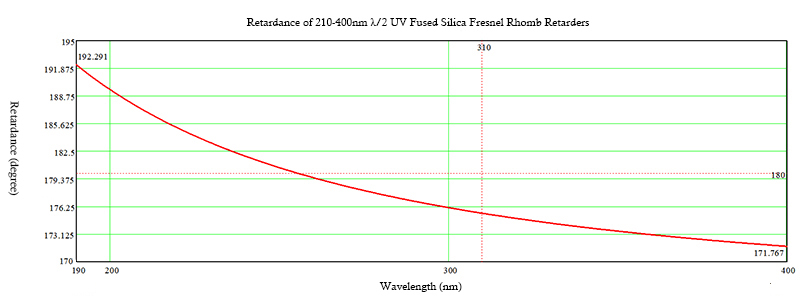
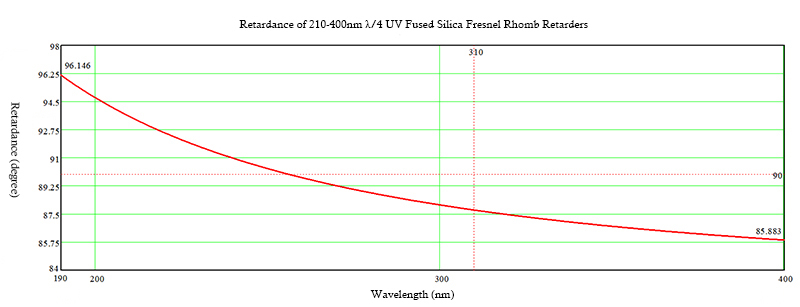
2. 350-2300nm Fresnel Rhomb Retarders of BK7 (λ/2 and λ/4 retardance)
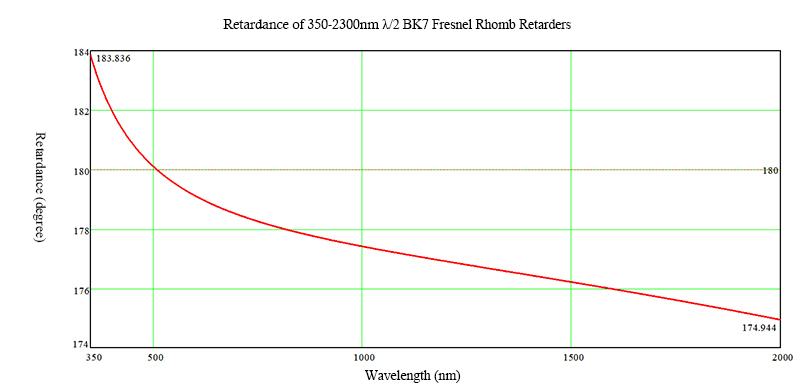
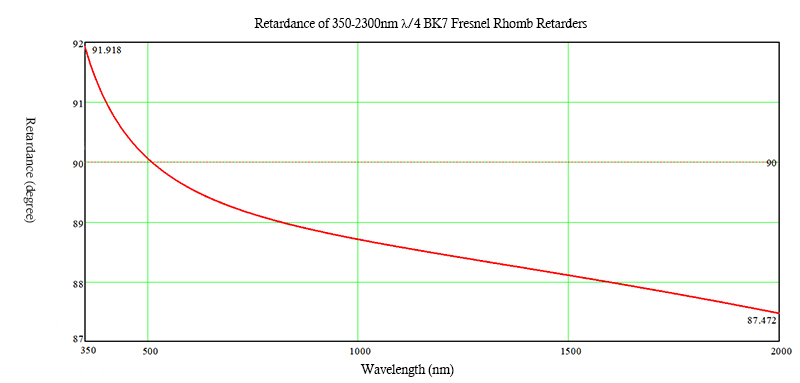
3. 2000-15000nm Fresnel Rhomb Retarders of ZnSe (λ/2 and λ/4 retardance)
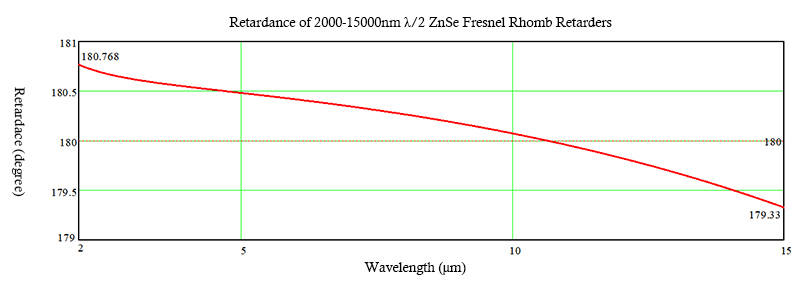

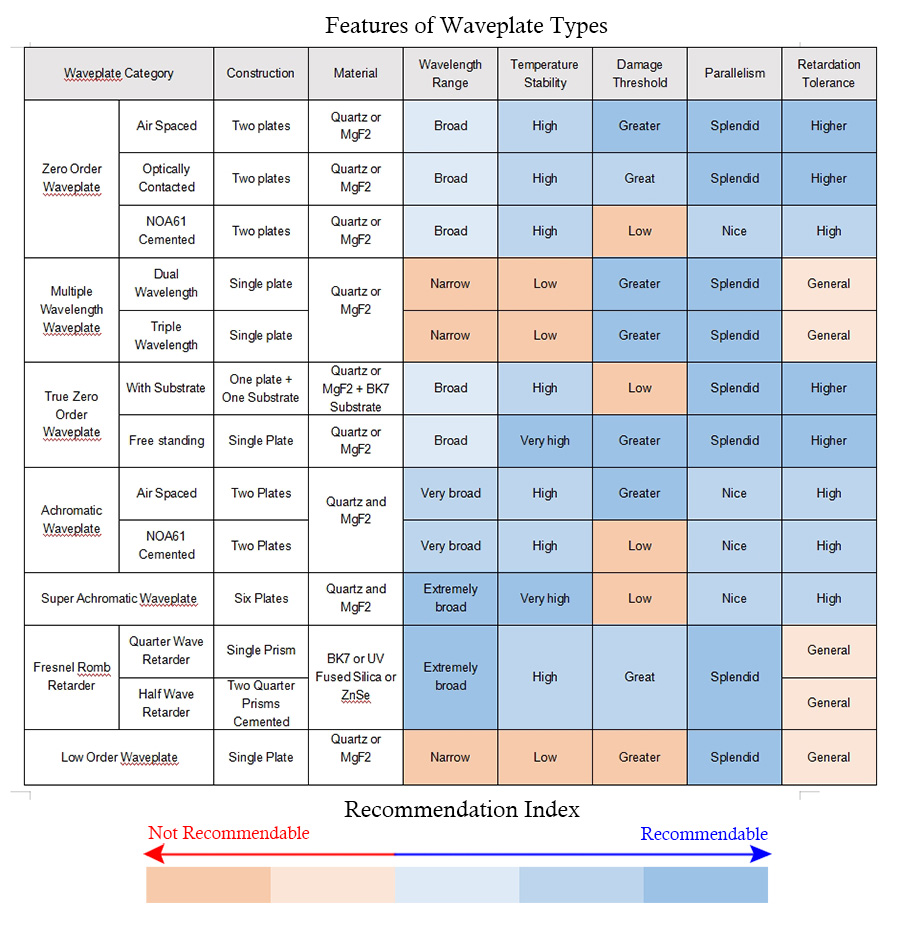
Understanding different types of Waveplates and Retarders are equally as important as figuring out their working principle, especially for buyers. Don’t worry, Shalom EO edited a brief guide for you, after reading that you might have a much clarified and profound understanding of waveplates.
Low Order Waveplates or Multiple Order Waveplates
Due to difficulties in the manufacturing stage, it could be hard to churn out large quantities of waveplates that are ultra-thin and which produce exactly the desired fractional retardance. The Low Order Waveplates, Or Multiple Order Waveplates are relatively thick and generate the desired retardation with several additional wavelengths of phase delay. Because light waves repeat themselves periodically, a low order half waveplate, which produces a phase delay of lambda/2 plus 3 additional lambdas could also function as a half waveplate. The word “Order” here refers to the number of additional wavelengths generated. In this text, a low order waveplate is better than multiple order waveplates because it produces less addition phase delay and its retardation is more precise. However, the surplus of retardation also implies that they are much more sensitive to changes in wavelengths, temperature, or the AOI than their zero order counterparts.
Generally speaking, if you are looking for cheap buying-in-bulk waveplates for single wavelength applications, then Low Order Waveplates are just right for you. Shalom EO offers Low Order Waveplates of two material options (Quartz for Visible to Near-IR spectral or MgF2 for greater wavelengths up to 7000nm).
Zero Order Waveplates
Zero Order Waveplates are essentially comprised of two multiple order or low order waveplates with their axes orthogonally aligned (aligning the fast axis of one waveplate to the slow axis of the another), the resulting retardation is the difference between two individual retardations produced by respectively by the two constituent waveplates. By combining two single waveplates together, Zero Order Waveplates effectively offset the impacts of external factors (wavelength change, ambient temperature) on the retardation, which means the retardation will be much more constant compared to the low order waveplates, making them competent for applications involving broadened wavelength. Nevertheless, they might still have rather susceptive responsiveness to variations of the angle of incidence.
Shalom EO offers three types of Zero Order Waveplates: Air spaced Zero Order Waveplates, Optically Contacted Zero Order Waveplates and NOA61 Cemented Zero Order Waveplates. While the cemented zero order waveplates are the common alternative, for high energy operations, consider Air spaced zero order waveplates and optically contacted zero order waveplates, since the two types have relatively higher damage threshold than the cemented versions.
True Zero Order Waveplates
True Zero Order Waveplates are waveplates of single-plate structure and provide exactly the required retardation, therefore its thickness is usually only several micrometers. Although requiring relatively strict processing, the contracted thickness contributes to more superior retardation constancy against wavelength variations or climate changes than conventional Zero Order Waveplates. Shalom EO offers True Zero Order Waveplates made from Quartz (for 532-3000nm) or MgF2 (for long-wavelength applications from 3000-7000nm), the single plate versions are relatively fragile but are of high damage threshold, while the versions cemented with BK7 substrates are much easy to handle, but are of lower damage threshold.
Achromatic Waveplates
Achromatic Wavepltes are constructed by one MgF2 Waveplate and one Quartz Waveplates with their axes orthogonally aligned, of which the birefringent properties are complementary, achieving the required focal length while minimizing chromatic dispersion. Through this approach the intrinsic influence of wavelength shifts on the retardation is drastically reduced, making achromatic waveplates even more retardation-constant than zero order waveplates, thus eminent for various Broadband applications spanning wide spectral ranges (e.g. from 900-2000nm). Two application examples are Tunable laser sources, Femtosecond laser systems, etc.
Super Achromatic Waveplates
Super Achromatic Waveplates are virtually an upgraded version of achromatic waveplates. The operation principle of super achromatic waveplates is the same as that described of achromatic waveplates. Super achromatic waveplates are also compounded by two crystal materials (e.g. quartz and magnesium fluoride), but instead of two as in the case of achromatic waveplates, they consists of six single waveplates (three of Quartz, three of MgF2), the result is exceedingly flat retardation over even wider wavelength ranges.
Fresnel Rhomb Retarders
Fresnel Rhomb Retarders operates upon an entirely different principle other than exploiting the birefringence. A Fresnel Rhomb introduces phase difference between the components of light using total internal reflection. When light is projected on the interface, the electric field of the light wave splits into two perpendicular components, the s component, and the p component. The rhombs are strategically processed into the shape of a right parallelepiped, so that with the angle of incidence cautiously chosen, the p component will proceed lambda/8 relative to the s component at each total internal reflection underwent. When light emerges, after experiencing two total internal reflections, the p component will eventually be lambda/4 ahead of the s component, thus realizing the same function of a Quarter Waveplate. When constructing a Half Wave Fresnel Rhomb Retarder, two rhombs are cemented in tandem to avert reflections at the interface.
The Fresnel Rhombs are usually made from glass materials, which are non-birefringent, the typical three being BK7, UV Fused Silica or ZnSe. Because the retardation introduced by the rhomb is related to the refractive index, which only varies slightly over a wide wavelength range, the Fresnel Rhomb Retarders have even broader wavelength capabilities than other broadband waveplates such as achromatic waveplates.
Dual Wavelength Waveplates
Dual Wavelength Waveplates introduce two retardation values for two wavelengths through the fitting of the refractive index at different wavelengths. Dual Wavelength Waveplates are particularly useful when used in conjunction with other polarization-sensitive components to separate coaxial laser beams of different wavelengths or elevate and promote the conversion efficiency of Solid State SHG Lasers. Additionally, Dual Wavelength Waveplates could also be applied to THG Systems. Triple Wavelength Waveplates could also be customized by Shalom EO at your request.